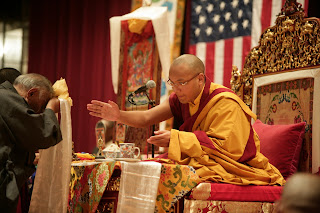Ogyen Trinley Dorje (Tibetan: ཨོ་རྒྱན་འཕྲིན་ལས་རྡོ་རྗེ།,; born June 26, 1985), also written Urgyen Trinley Dorje , is a claimant to the title of 17th Karmapa.
The Karmapa is head of the Karma Kagyu school, one of the four main schools of Tibetan Buddhism. Ogyen Trinley Dorje and Thaye Dorje are the persisting claimants to that office and title.
Biography
Born in Lhatok Township, Qamdo County, Tibet Autonomous Region, to primarily nomadic parents, Ogyen Trinley Dorje is said to have identified himself to family members as the Karmapa early in childhood. (The identification of the 17th Karmapa is disputed. See Karmapa controversy.) Known as Apo Gaga, he was seven years old before he was recognized by a search party headed by the Tai Situpa, following instructions left by the previous Karmapa in a prophetic letter and hidden in a locket entrusted to Tai Situpa. Ogyen Trinley Dorje was installed at Tsurphu Monastery (Wylie: Mtshur-phu, ZYPY: Curpu), the traditional seat of the Karmapa in Tibet, with the official sanction of the Central People's Government who declared him to be a "living Buddha", the first time a communist Chinese government has recognised a tulku. Critics of this collusion call it a "bad precedent" for the 11th Panchen Lama and the next Dalai Lama, and urged the Tai Situpa to smuggle Ogyen Trinley out of Tibet. The Tai Situpa resisted, insisting that there was a need to "legalize" the boy's position in Tibet, and so Ogyen Trinley Dorje lived at Tsurphu Monastery for another seven years.
At the age of 14, he escaped to India through Nepal, arriving at the Tibetan exile quarters at McLeod Ganj on January 5, 2000. Ogyen Trinley Dorje had felt that he was unable to obtain in China the specialized instruction he needed to complete his studies and to realize his full spiritual authority. The Chinese government was embarrassed by the escape, but it did "not [excoriate] him as they [did] the Dalai Lama." Despite a lack of evidence, some believe that he is a Chinese spy. He resides at Gyuto Monastery in Sidhbari, near Dharamsala.
From May 15 - June 2, 2008, he made his first trip to the West, visiting several cities in the United States (notably New York City, Boulder, Colorado, and Seattle, Washington) and was formally enthroned in the North American seat of the Karmapas at Karma Triyana Dharmachakra monastery in Woodstock, NY. All across the country, he gave multiple teachings on compassion and the environment, gave the reading transmission for a new form of Ngondro, and bestowed several empowerments, including Avalokiteshvara and Guru Rinpoche. He also spoke eloquently about the special challenges of the rapid pace of modern society, and the virtues of the Internet as a tool for the study and practice of Buddhadharma.
In July 2008 he requested permission to visit monasteries in Lahaul and Spiti (Himachal Pradesh) and in Ladakh (Jammu and Kashmir). The Indian government initially refused to allow these visits without giving a reason. It was speculated that the reason might have been that these areas are close to the China border and that the Beijing Olympics were approaching, even though he had made it clear that he does not promote Tibetan independence and has no political stance on China. India eventually allowed his tour, which began in Ladakh, followed by Lahaul and Spiti, including the famous Tabo Monastery.
Requests to visit USA and Europe in 2010 were denied by the Indian government.
On 09 July 2011, His Holiness arrived back in the United States for his second visit. From 09 - 17 July, he participated in the Kalachakra initiation bestowed by HH the XIV Dalai Lama in Washington, DC, then traveled by train to his seat at Karma Triyana Dharmachakra and also visited both his center in New Jersey and Hunter College in New York City, returning to India on 04 August. During his visit, he taught extensively on compassion, gave Refuge, and bestowed the empowerments of both the Four-Armed and Thousand-Armed forms of Avalokiteshvara. He also granted an interview with Laurie Goodstein of the New York Times, which was published on 28 July 2011.
From : www.wikipedia.org


